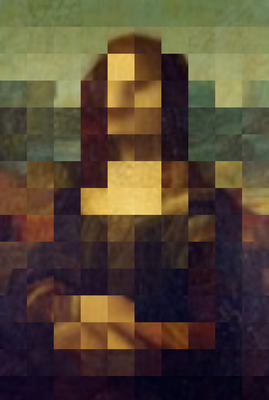p5art
Splitting Up an Image
Grabbing a subsection of an image
When Image.get() is given 4 parameters, it will take a rectangular section of the image.
Image.get(x, y, w, h)
x: Horizontal location of cutting rectangley: Vertical location of cutting rectanglew: Width of the cutting rectangleh: Height of the cutting rectangle
Here is a visual that shows how the sub section is calculated:

Here is an example where we can get a sub section of an image.
let img;
let thumb;
function preload(){
img = loadImage('/imgs/mona.jpg')
}
function setup() {
createCanvas(400, 400);
thumb = img.get(164, 143, 80, 80); //grab a sub section of the image
}
function draw() {
background(220);
image(thumb, mouseX, mouseY); //draw the sub image at the mosue pointer
}
Using an Array to Store and Display Parts of an Image
Arrays are a data structure that can hold multiple items. We can use an array to store slices of an image.
One-Dimensional, Slices
This example shows how to slices the image into segments and display the segments as horizontal strips.
let mona;
let numSlices;
let sliceWidth;
let slices = [];
function preload() {
mona = loadImage("./mona-lg.jpg"); //this image must be in the same folder as the sketch code
}
function setup() {
createCanvas(mona.width, mona.height);
numSlices = 10;
sliceWidth = mona.width / numSlices;
slicify(); //slices image up and adds to the slices array
noLoop();
}
function draw() {
background(220);
displayImage();
}
function mousePressed() {
redraw();
}
function slicify() {
//loop from 0 to number of slices
for (let i = 0; i < numSlices; i++) {
let slice = mona.get(i * sliceWidth, 0, sliceWidth, height); //cut out part of t eimage
slices.push(slice); //add this slice to the slices array.
}
}
//display the image
function displayImage() {
slices = shuffle(slices); //randomize the array
let x = 0; //keep track of horizontal position
for (let i = 0; i < slices.length; i++) {
image(slices[i], x, 0);
x += sliceWidth; //move horiziontlly
}
}

Two-Dimensional, Grid
Now that we have the code to make slices, we can put that inside another for loop to get a grid of image cells
let mona;
let numRows, numCols;
let cellWidth, cellHeight;
let cells = [];
function preload(){
mona = loadImage('./mona-lg.jpg'); //this image must be in the same folder as the sketch code
}
function setup() {
createCanvas(mona.width, mona.height);
numCols = 10; //control the grid
numRows = 10;
cellWidth = mona.width/numCols;
cellHeight = mona.height/numRows;
print(cellWidth, cellHeight)
gridify(); //create an image grid
print(cells.length);
noLoop();
}
function draw() {
background(220);
displayImage();
}
function mousePressed(){
redraw()
}
function gridify(){
for(let i = 0; i < numRows; i++){
for(let j = 0; j < numCols; j++){
//grab a subsection of the image
let cell = mona.get(j * cellWidth, i * cellHeight, cellWidth, cellHeight);
cells.push(cell); //add to the array of image cells
}
}
}
//display the image
function displayImage(){
cells = shuffle(cells); //randomize the array
let x = 0;
let y = 0;
for(let i = 0; i < cells.length; i++){
image(cells[i], x, y); //display a cell
x += cellWidth; //move horiziontlly
if(x >= width){ //break to next line
x = 0;
y += cellHeight; //move vertically
}
}
}

With get() the possibilities for manipulation are pretty endless. We could weave two images together. We could split the image into tiles and randomize the order.
A Final Example
Inspired by a manipulated photo by Kensuke Koiko, I wanted to make a p5 version that would work with any image.
First I use a for loop to layout a grid of smaller squares on Mona.

Using this same geometry, I grabbed a subsection of the image at each square and stored it into an array called thumbs.
I then display each thumb, enlarging them to fill the canvas.

You can see the code here